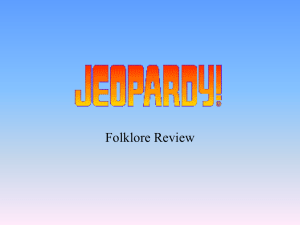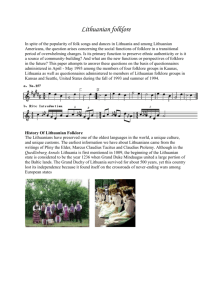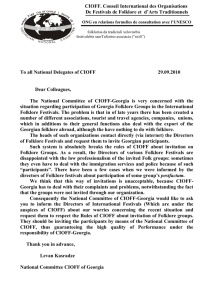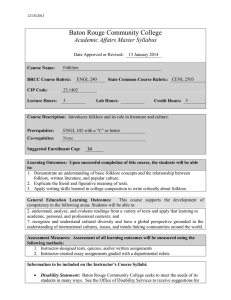CURRICULUM PROPOSAL College of the Redwoods 1. Course ID and Number:
advertisement
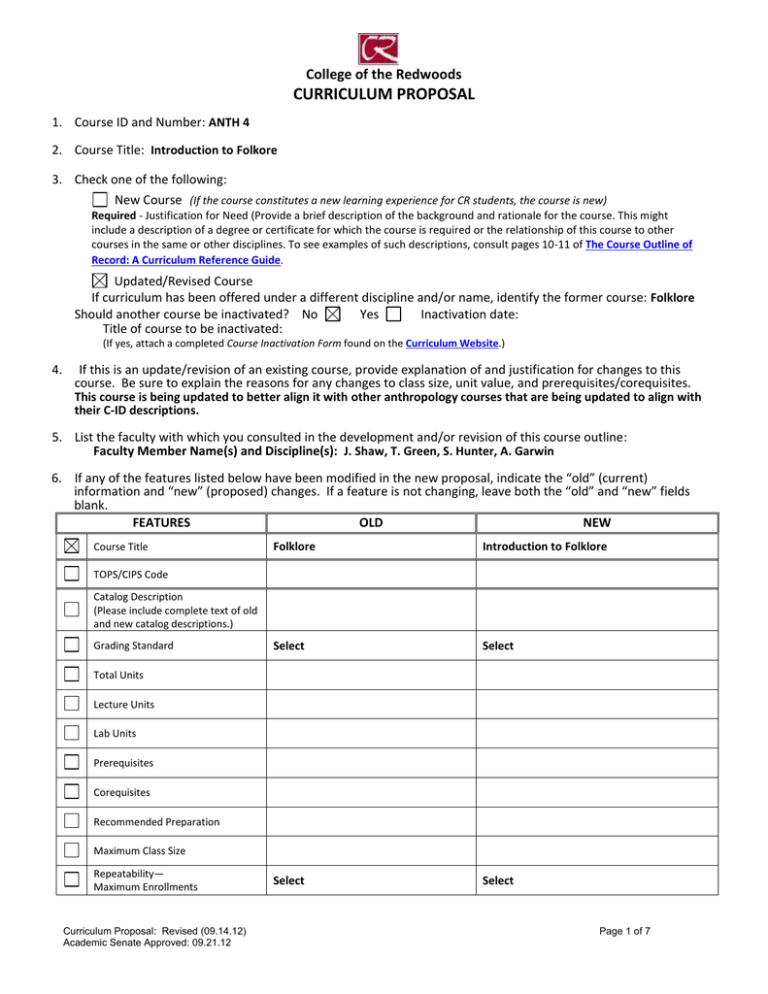
College of the Redwoods CURRICULUM PROPOSAL 1. Course ID and Number: ANTH 4 2. Course Title: Introduction to Folkore 3. Check one of the following: New Course (If the course constitutes a new learning experience for CR students, the course is new) Required - Justification for Need (Provide a brief description of the background and rationale for the course. This might include a description of a degree or certificate for which the course is required or the relationship of this course to other courses in the same or other disciplines. To see examples of such descriptions, consult pages 10-11 of The Course Outline of Record: A Curriculum Reference Guide. Updated/Revised Course If curriculum has been offered under a different discipline and/or name, identify the former course: Folklore Should another course be inactivated? No Yes Inactivation date: Title of course to be inactivated: (If yes, attach a completed Course Inactivation Form found on the Curriculum Website.) 4. If this is an update/revision of an existing course, provide explanation of and justification for changes to this course. Be sure to explain the reasons for any changes to class size, unit value, and prerequisites/corequisites. This course is being updated to better align it with other anthropology courses that are being updated to align with their C-ID descriptions. 5. List the faculty with which you consulted in the development and/or revision of this course outline: Faculty Member Name(s) and Discipline(s): J. Shaw, T. Green, S. Hunter, A. Garwin 6. If any of the features listed below have been modified in the new proposal, indicate the “old” (current) information and “new” (proposed) changes. If a feature is not changing, leave both the “old” and “new” fields blank. FEATURES OLD NEW Course Title Folklore Introduction to Folklore Select Select Select Select TOPS/CIPS Code Catalog Description (Please include complete text of old and new catalog descriptions.) Grading Standard Total Units Lecture Units Lab Units Prerequisites Corequisites Recommended Preparation Maximum Class Size Repeatability— Maximum Enrollments Curriculum Proposal: Revised (09.14.12) Academic Senate Approved: 09.21.12 Page 1 of 7 Textbook update Other 1. DATE: 12/11/13 2. DIVISION: Arts, Languages, and Social Sciences 3. [CB01] COURSE ID AND NUMBER: ANTH 4 4. [CB02] COURSE TITLE: Introduction to Folklore (Course title appears in Catalog and schedule of classes.) 5. SHORT TITLE: Intro to Folklore (Short title appears on student transcripts and is limited to 30 characters, including spaces.) 6. [CB03] LOCAL ID (TOPS): 2202.00 Taxonomy of Program Codes 7. NATIONAL ID (CIP): 450201 Classification of Instructional Program Codes 8. DISCIPLINE(S): Anthropology Select from Minimum Qualifications for Faculty Course may fit more than one discipline; identify all that apply: 9. FIRST TERM NEW OR REVISED COURSE MAY BE OFFERED: Fall 2014 10. COURSE UNITS (Note: 1 lecture unit requires 18 hours in-class/36 hours out-of-class; 1 lab unit requires 54 in-class hours) TOTAL UNITS: 3 3 LECTURE UNITS: 3 LAB UNITS: 0 TOTAL HOURS: [CB07] [CB06] min. units max. units 54 54 min. units max. units LECTURE HOURS: 54 LAB HOURS: 0 11. MAXIMUM CLASS SIZE: 35 12. WILL THIS COURSE HAVE AN INSTRUCTIONAL MATERIALS FEE? No Yes Fee: $ If yes, attach a completed Instructional Materials Fee Request Form found on the Curriculum Website. GRADING STANDARD Letter Grade Only Pass/No Pass Only [CB12] Is this course a repeatable lab course? No Grade-Pass/No Pass Option Yes If yes, how many total enrollments? Select Is this course to be offered as part of the Honors Program? No Yes If yes, explain how honors sections of the course are different from standard sections. Honors students will be expected to write longer versions of any assigned papers or projects, focusing to a greater degree on controversies within the subject of folklore. They will be expected to consider the issues and problems raised in these assignments in more detail than non-Honors students and to conduct more in-depth research using library and online resources, including professional publications. If this is a section exclusively for Honors students, students should also be "in charge" of portions of the class, responsible for presentations and coordinating educational activities for the entire class. These student-led portions of the class may be done individually or in groups. CATALOG DESCRIPTION -- The catalog description should clearly describe for students the scope of the course, its level, and what kinds of student goals the course is designed to fulfill. The catalog description should begin with a sentence fragment. A course in the collecting, presenting, and analyzing of oral, material, and written forms of folklore, such as urban legends, folk art, foodways, folk music, folkspeech, gestures, and superstitions. Emphasis will be on analysis of collections and the use of folklore as a tool for understanding a variety of cultures. Special Notes or Advisories (e.g. Field Trips Required, Prior Admission to Special Program Required, etc.): PREREQUISITE COURSE(S) No Yes Rationale for Prerequisite: Course(s): Curriculum Proposal: Revised (09.14.12) Academic Senate Approved: 09.21.12 Page 2 of 7 Describe representative skills without which the student would be highly unlikely to succeed. COREQUISITE COURSE(S) No Yes Rationale for Corequisite: Course(s): RECOMMENDED PREPARATION No Yes Course(s): English 150 Rationale for Recommended Preparation: Since this course carries with it UC and CSU equivalent transfer units, students must be able to meet college-level reading and writing standards to successfully complete the course. Being able to read and write at, or near, a college level is necessary for students to understand assigned texts, follow detailed written instructions, and present findings in writing on essay exams and in papers. COURSE LEARNING OUTCOMES –This section answers the question “what will students be able to do as a result of taking this course?” State some of the objectives in terms of specific, measurable student actions (e.g. discuss, identify, describe, analyze, construct, compare, compose, display, report, select, etc.). For a more complete list of outcome verbs please see Public Folders>Curriculum>Help Folder>SLO Language Chart. Each outcome should be numbered. 1. Analyze primary and secondary sources in order to extract information relevant to an issue of concern in folklore. 2. Exhibit the ability to think logically about issues in folklore and how people have interpreted those issues. 3. Describe basic principles of folklore and how these principles are used to decipher how folklore is interpreted. COURSE CONTENT–This section describes what the course is “about”-i.e. what it covers and what knowledge students will acquire Concepts: What terms and ideas will students need to understand and be conversant with as they demonstrate course outcomes? Each concept should be numbered. 1. Working and scholarly definitions of folklore. 2. Genres of folklore. 3. A brief history of the study of folklore. 4. Definition of folk group and an understanding of how folk groups form. 5. An ability to describe examples of folk groups including family, school, and occupational groups. 6. Define and explain what tradition is, as well as how traditions create and form individual and community identities. 7. Traditions have dynamic and conservative elements and include invented elements. 8. The concept of authentic traditions is controversial. 9. Define and explain what ritual is, including both sacred and secular rituals. 10. The concept of liminality and ritual space. 11. An understanding of the major types of rituals, including definitions and examples. 12. A definition of performance, including performance texts. 13. Recognizing the importance of the context of a performance 14. The complex nature of the aesthetics of performance. 15. The varied approaches to interpreting folklore, including functionalism, structuralism, psychoanalytic interpretation, and post-structural approaches. 16. The basic methods used by folklore researchers, including interpersonal and ethical concerns. Issues: What primary tensions or problems inherent in the subject matter of the course will students engage? Each issue should be numbered. 1. Cultural relativism: Although cultures vary greatly, they can not and should not be judged in any relative or absolute manner. 2. Cultural dynamism: Cultures are dynamic, not static. Even "traditions" change through time, so that there never were any "original" or "pure" forms of any culture. 3. Reflexivity: The presence of a folklorist may influence performers and audience members. Themes: What motifs, if any, are threaded throughout the course? Each theme should be numbered. 1. Interpreting Folklore: It is important to not only look at the structure of a text, but also at its context, in order to understand its meaning. 2. Means of Transmission: Folklore is informally learned, unofficial knowledge about the world, ourselves, our communities, our beliefs, our cultures and our traditions. 3. Variety: While folklore includes analyses of oral narratives, it also encompasses all types of lore transmitted within and between peer-groups and includes traditional knowledge. Studying folklore potentially involves all type of lore Curriculum Proposal: Revised (09.14.12) Academic Senate Approved: 09.21.12 Page 3 of 7 transmitted by tradition. Skills: What abilities must students have in order to demonstrate course outcomes? (E.g. write clearly, use a scientific calculator, read college-level texts, create a field notebook, safely use power tools, etc). Each skill should be numbered. 1. Critical reading of presentations of folklore and folklore studies. 2. Argumentative and analytical writing on in-class tests and papers. 3. Sustain an argument through the use of anthropological evidence and logic in class discussions, essay exam questions, and term papers. 4. Application of class concepts to real-world examples and situations. 5. Participation in discussions of complex issues. REPRESENTATIVE LEARNING ACTIVITIES –This section provides examples of things students may do to engage the course content (e.g., listening to lectures, participating in discussions and/or group activities, attending a field trip). These activities should relate directly to the Course Learning Outcomes. Each activity should be numbered. 1. 2. 3. 4. 5. 6. 7. Participating in in-class discussions and exercises. Completing individual/group writing projects. Taking written or oral quizzes. Conducting field assignments. Writing journal reviews. Completing other writing assignments. Taking exams that include essay questions. ASSESSMENT TASKS –This section describes assessments instructors may use to allow students opportunities to provide evidence of achieving the Course Learning Outcomes. Each assessment should be numbered. Representative Assessment Tasks (These are examples of assessments instructors could use.): 1. Pop quizzes. 2. Essay and objective test questions. 3. Written papers utilizing the student's own outside fieldwork and/ or library research. 4. Periodic assignments presented in class and in written forms. Required Assessments for All Sections (These are assessments that are required of all instructors of all sections at all campuses/sites. Not all courses will have required assessments. Do not list here assessments that are listed as representative assessments above.): There will be at least one major writing assignment with formal writing assignments totaling at least 10 pages, as well as some essay questions on each test. Students will be required to conduct their own research as a part of the writing assignment(s). EXAMPLES OF APPROPRIATE TEXTS OR OTHER READINGS –This section lists example texts, not required texts. Author, Title, and Date Fields are required Author George H. Schoemaker Title The Emergence Of Folklore In Everyday Life: A Fieldguide And Sourcebook Author Martha Sims and Martine Stephens Title Date Date 2008 Living Folklore: An Introduction to the Study of People and Their Traditions 2005 Author Barre Toelken Title Author Title Dynamics Of Folklore Date 1996 Date Other Appropriate Readings: 1. COURSE TYPES Is the course part of a Chancellor’s Office approved CR Associate Degree? No Yes If yes, specify all program codes that apply. (Codes can be found in Outlook/Public Folders/All Public Folders/ Curriculum/Degree and Certificate Programs/choose appropriate catalog year): Required course for degree(s) Restricted elective for degree (s) BEHAV.LA.AA Restricted electives are courses specifically listed (i.e. by name and number) as optional courses from which students may choose to complete a specific number of units required for an approved degree. 2. Is the course part of a Chancellor’s Office approved CR Certificate of Achievement? No Yes If yes, specify all program codes that apply. (Codes can be found in Outlook/Public Folders/All Public Folders/ Curriculum/Degree Curriculum Proposal: Revised (09.14.12) Academic Senate Approved: 09.21.12 Page 4 of 7 and Certificate Programs/choose appropriate catalog year): Required course for certificate(s) Restricted elective for certificate(s) Restricted electives are courses specifically listed (i.e. by name and number) as optional courses from which students may choose to complete a specific number of units required for an approved certificate. 3. [CB24] Is the course Stand Alone? No Yes (If “No” is checked for BOTH #1 & #2 above, the course is stand alone.) 4. [CB08] Basic Skills: NBS Not Basic Skills 5. [CB10] Work Experience: NWE Not Coop Work Experience 6. Course eligible Career Technical Education funding (applies to vocational and tech-prep courses only): No 7. [CB23] Course eligible Economic Workforce Development funding : No Yes Yes (If TOPS code has an asterisk it is indicative that the course is vocational.) 8. [CB11] Purpose: Y Credit Course Course Classification Status 9. Accounting Method: W Weekly Census 10. [CB13] Disability Status: N Not a Special Class 11. [CB09] Course SAM Priority Code: E Not Occupational Definitions of SAM Priority Codes COURSE TRANSFERABILITY 1. [CB05] Current Transferability Status: A Transferable to both UC and CSU 2. [CB21] Course Prior to Transfer Level: Y Not Applicable Definitions of Course Prior to Transfer Levels CURRENT TRANSFERABILITY STATUS (Check at least one box below): This course is currently transferable to: Neither CSU nor UC CSU as general elective credit CSU as a specific course equivalent (see below) If the course transfers as a specific course equivalent give course number(s)/ title(s) of one or more currently-active, equivalent lower division courses from CSU. 1. Course , Campus 2. Course , Campus UC as general elective credit UC as specific course equivalent If the course transfers as a specific course equivalent give course number(s)/ title(s) of one or more currently-active, equivalent lower division courses from UC. 1. Course , Campus 2. Course , Campus PROPOSED CSU TRANSFERABILITY (Check at least one of the boxes below): No Proposal Remove as General Education Propose as General Elective Credit Propose as a Specific Course Equivalent (see below) If specific course equivalent credit is proposed, give course number(s)/ title(s) of one or more currently-active, equivalent lower division courses from CSU. 1. Course , Campus 2. Course , Campus PROPOSED UC TRANSFERABILITY (Check one of the boxes below): No Proposal Curriculum Proposal: Revised (09.14.12) Academic Senate Approved: 09.21.12 Page 5 of 7 Remove as General Education Propose as General Elective Credit OR Specific Course Equivalent (fill in information below) If “General Elective Credit OR Specific Course Equivalent” box above is checked, give course number(s)/ title(s) of one or more currently-active, equivalent lower division courses from UC. 1. Course , Campus 2. Course , Campus CURRENTLY APPROVED GENERAL EDUCATION Check at least one box below): Not currently approved CR CR GE Category: CSU CSU GE Category: IGETC IGETC Category: PROPOSED CR GENERAL EDUCATION (Check at least one box below): No Proposal ____ Approved as CR GE by Curriculum Committee: _____ _ Remove as General Education Review to maintain CR GE Status New GE Proposal ____ Not Approved (DATE) CR GE Outcomes GE learning outcomes in Effective Communication, Critical Thinking, and Global Awareness must be addressed in all general education courses. Effective Communications: Explain how the proposed GE course fulfills at least one of the CR GE outcomes in this category. Critical Thinking: Explain how the proposed GE course fulfills at least one of the CR GE outcomes in this category. Global Awareness: Explain how the proposed GE course fulfills at least one of the CR GE outcomes in this category. GE Criteria for Breadth and Generality GE courses should be broad and general in scope. Typically such courses are introductory-- not advanced or specialized—and the content encompasses a broad spectrum of knowledge within a given field of study. Explain how the proposed GE course fulfills GE criteria for breadth and generality. CR GE Area Designation Course Learning Outcomes and Course Content should provide evidence of appropriate GE Area Designation. Additional rationale for GE Area Designation (optional): Natural Science Social Science Humanities Language and Rationality Writing Oral Communications Analytical Thinking PROPOSED CSU GENERAL EDUCATION BREADTH (CSU GE) (Check at least one box below): No proposal A. Communications and Critical Thinking A1 – Oral Communication A2 – Written Communication A3 – Critical Thinking C. Arts, Literature, Philosophy, and Foreign Language C1 – Arts (Art, Dance, Music, Theater) C2 – Humanities (Literature, Philosophy, Foreign Language) Curriculum Proposal: 09.14.12 rev Academic Senate Approved: 09.21.12 B. Science and Math B1 – Physical Science B2 – Life Science B3 – Laboratory Activity B4 – Mathematics/Quantitative Reasoning D. Social, Political, and Economic Institutions D0 – Sociology and Criminology D1 – Anthropology and Archeology D2 – Economics D3 – Ethnic Studies D5 – Geography Page 6 of 7 E. Lifelong Understanding and Self-Development E1 – Lifelong Understanding E2 – Self-Development D6 – History D7 – Interdisciplinary Social or Behavioral Science D8 – Political Science, Government and Legal Institutions D9 – Psychology Rationale for inclusion in this General Education category: Same as above Proposed Intersegmental General Education Transfer Curriculum (IGETC) (Check at least one box below): No proposal 1A – English Composition 1B – Critical Thinking-English Composition 1C – Oral Communication (CSU requirement only) 2A – Math 3A – Arts 3B – Humanities 4A – Anthropology and Archaeology 4B – Economics 4E – Geography 4F – History 4G – Interdisciplinary, Social & Behavioral Sciences 4H – Political Science, Government & Legal Institutions 4I – Psychology 4J – Sociology & Criminology 5A – Physical Science 5B – Biological Science 6A – Languages Other Than English Rationale for inclusion in this General Education category: Same as Above Submitted By: Justine M. Shaw Division Chair/Director: Tracey Thomas Approved by Curriculum Committee: No Academic Senate Approval Date: 03.07.14 Curriculum Proposal: 09.14.12 rev Academic Senate Approved: 09.21.12 Tel. Ext. 4322 Review Date: 2-4-2014 Date: 1.25.14 CURRICULUM COMMITTEE USE ONLY Yes Date: 02.28.14 Board of Trustees Approval Date: 04.01.14 Page 7 of 7
